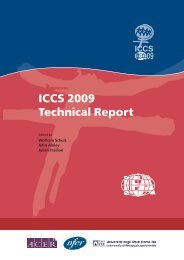Teacher Education and Development Study in Mathematics - IEA
Teacher Education and Development Study in Mathematics - IEA
Teacher Education and Development Study in Mathematics - IEA
Create successful ePaper yourself
Turn your PDF publications into a flip-book with our unique Google optimized e-Paper software.
PART 1: SALARY RELATIVITIES<br />
23<br />
A major issue associated with estimat<strong>in</strong>g earn<strong>in</strong>gs <strong>in</strong> different occupations, particularly<br />
when mak<strong>in</strong>g comparisons with teach<strong>in</strong>g, is whether to use yearly earn<strong>in</strong>gs (salary)<br />
or earn<strong>in</strong>gs per hour (wages). Because teachers <strong>in</strong> some countries work fewer than<br />
40 hours per week (even <strong>in</strong>clud<strong>in</strong>g preparation time—see OECD, 2004a) <strong>and</strong>, <strong>in</strong> all<br />
countries, work fewer than 12 months per year, their hourly earn<strong>in</strong>gs usually compare<br />
more favorably than their salaries with hourly earn<strong>in</strong>gs <strong>in</strong> other professions. Many<br />
economists consider hourly earn<strong>in</strong>gs a better measure of compensation because these<br />
allow us to measure the cost of the trade-off between work<strong>in</strong>g an hour <strong>and</strong> engag<strong>in</strong>g <strong>in</strong><br />
leisure activities. Economists also tend to argue that hourly wages are a better predictor<br />
of whether an <strong>in</strong>dividual will choose one type of work over another. Teach<strong>in</strong>g offers<br />
the possibility of work<strong>in</strong>g fewer than 12 months <strong>and</strong> a somewhat shorter workday (<strong>in</strong><br />
the classroom), factors appreciated by women <strong>in</strong> most societies, given that they, even <strong>in</strong><br />
post-<strong>in</strong>dustrial economies, still have primary responsibility for child-rear<strong>in</strong>g.<br />
Nevertheless, for those who are concerned with absolute earn<strong>in</strong>gs, <strong>and</strong> particularly for<br />
those who are <strong>in</strong> economies where it is difficult to get (part-year) vacation jobs, annual<br />
earn<strong>in</strong>gs probably offer a better means of comparison between teacher earn<strong>in</strong>gs <strong>and</strong><br />
earn<strong>in</strong>gs <strong>in</strong> “compet<strong>in</strong>g” occupations. If those teach<strong>in</strong>g do not want time off <strong>in</strong> the<br />
summer, then the value of that time is close to zero. As such, hourly wages calculated<br />
on the basis of the fewer annual hours worked by teachers overestimate teacher pay<br />
relative to remuneration from full-year jobs. Also, as Allegretto et al. (2004) po<strong>in</strong>t out,<br />
<strong>in</strong>consistencies <strong>in</strong> measur<strong>in</strong>g the number of hours that teachers <strong>and</strong> other professionals<br />
work per week <strong>and</strong> how many weeks they work per year lead to <strong>in</strong>accurate estimates of<br />
wages per hour. Accord<strong>in</strong>gly, where possible, we present both measures of earn<strong>in</strong>gs <strong>in</strong><br />
the case studies.<br />
If the relative salary of teachers—<strong>and</strong> probably the time trend of relative teacher<br />
salary—correlates positively with teacher quality, then what we would expect to f<strong>in</strong>d<br />
is a situation <strong>in</strong> which the higher the relative teacher salary <strong>in</strong> a country, the higher the<br />
mathematics performance of that country’s students. As mentioned, however, teacher<br />
salaries may be relatively high ma<strong>in</strong>ly because <strong>in</strong>come distribution is more equal <strong>in</strong><br />
the country; professional salaries are thus equal to one another no matter what the<br />
profession.<br />
We could also expect to f<strong>in</strong>d that student performance is higher <strong>in</strong> countries with<br />
higher <strong>in</strong>come per capita (better-educated parents) than <strong>in</strong> coutries with lower <strong>in</strong>come<br />
per capita <strong>and</strong> perhaps, as discussed earlier, <strong>in</strong> countries with more equal <strong>in</strong>come<br />
distribution for reasons related to how educational resources are distributed among<br />
students of lower <strong>and</strong> higher SES (see Chiu & Khoo, 2005, <strong>in</strong> this regard). Student<br />
performance on the TIMSS or PISA tests may also be higher <strong>in</strong> countries with a lower<br />
proportion of students <strong>in</strong> Grades 8 to 10 because these students represent a more<br />
selective group <strong>in</strong> the potential student population. Equations 1a <strong>and</strong> 1b describe the

















